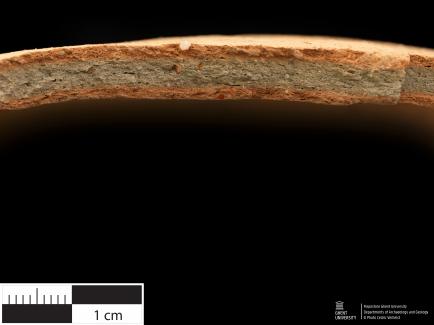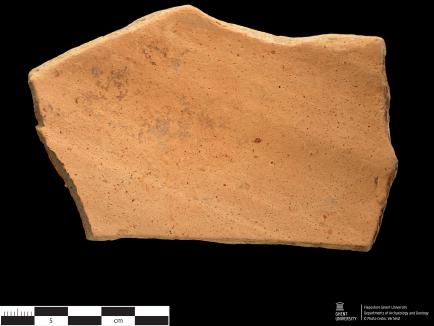Medieval - Red oxidized ware (6.RO.BE.0003)
Hand specimen pictures (macro & binocular)
Thin section pictures
Find location
- Category
- Red oxidized ware (Medieval)
- Fabric name
- Badorf-type ware
- Chronology
- Medieval > Early Medieval > Carolingian (8-9th century)
- Dating method(-s)
- morphological characteristics, radiocarbon dating
- Potters' mark
- No
- Additional information
- wall fragment with rouletting decoration, radiocarbon dates based on charcoal fragments from layers inside the kiln (7-8th century) are in contrast with the morphological aspects
Find location
- Site type
- Pottery production
- Location
- Belgium; Antwerpen; Beerse
- Site name
- Beerse, Asterstraat
- Excavation or Survey Team
- Excavations: ArcheoService (M. Vroomans); post-excavation: Erfgoedhuis Eindhoven, Archeologische Vereniging Kempen- en Peelland in collaboration with Nico Arts (gemeente Eindhoven) and Stephan Delaruelle (Archeologische Dienst Antwerpse Kempen).
- Additional contextual information
- excavation permit code: 2014/379; site-code: BE-AS-14; kiln feature numbers (wp3/S86, S206)
- Slip
- No
- Slip color
- Glaze
- No
- Glaze type
- Glaze color
- Glaze additives
- Additional information
- Slip
- No
- Slip color
- Glaze
- No
- Glaze type
- Glaze color
- Glaze additives
- Additional information
- Surface color
- orange
- Surface texture
- Rough
- Fracture color
- orange-grey-orange
- Inclusions (non-plastics/tempering)
- quartz (> 1mm), some larger (>1mm) quartz (milky white), oval red inclusions (up to several mm's) (=iron oxides ? clay pellets ?), rare angular black inclusions, rare grog fragment ?
- Matrix and voids
- /
- Diagnostic features
- Additional information
- BEERS-AST ST3
- Flepostore inventory nr.
- ARCH1.L1.A12c
- Original inventory nr.
- A0002
- Collection
- Archaeological Department, Ghent University
- Type
- Covered thin section
- Comparable thin section(s)
- Matrix
-
Reduced core and oxidized edges: Orange-red and browngrey fabric; light and dark brown (PPL), light brown and ark grey (XP).
Semi-homogenous matrix, non-calcerous with medium optical activity in the oxidized edges and low optical activity in the reduced core.
- ca. 60-70% - Inclusions
-
Quartz (++; mono, poly, r-sr, silt - coarse sand, weathering), feldspars (--; plagioclase; sr-r, ff), muscovite mica (++; el, ff), O/Fe (+), semi-plastics/clay pellets (+; iron-rich).
The coarse fraction varies from coarse to fine sand, the fine fraction from very fine sand to silt. Possibly bimodal. Grains are generally sub-rounded to rounded. Overall the fabric is poorly sorted.
- ca. 20-30% - Voids
-
Small to large vughs and planar voids, well aligned parallel to edge, drying cracks around semi-plastics/clay pellets.
- ca. 10-20% - Diagnostic features
- The fabric is characterized by a reduced core and oxidized edges. The matrix is semi-homogenous with medium to low optical activity and moderately high porosity. Dominant quartz inclusions with frequent muscovite mica, common opaques/iron oxides and semi-plastics/clay pellets, and rare feldspars. Coarse fraction likely represents a sand temper. Overall poorly sorted.
- Additional information
- Likely sand temper (coarse fraction).
- Sample type
- Pottery
- Inventory number
- 6.RO.BE.0003
- Collection
- Archaeological Department, Ghent University
- Donating institute/person
- Nico Arts (gemeente Eindhoven)
- Host collection
- Archeologische Dienst Antwerpse Kempen/Erfgoedhuis Eindhoven
- Other samples available
- No
- Sample collection method
- Archaeological Excavation
Arts et al. 2019
- Full reference
-
Arts N., Deforce K. & Heirbaut E. 2019. A Carolingian settlement with two kilns of Badorf-type pottery at Beerse (Campine Region, Belgium). Unpublished article draft: 1-22.
Vroomans, 2014
- Full reference
-
Vroomans J.-M. 2014. Beerse - Asterstraat. Evaluatierapport van het definitief archeologisch onderzoek. Archeologisch rapport ArcheoService.
Cite this page as: Flepostore - https://flepostore.ugent.be/ceramics/6-ro-be-0003
Last modified: 2024-04-27.






